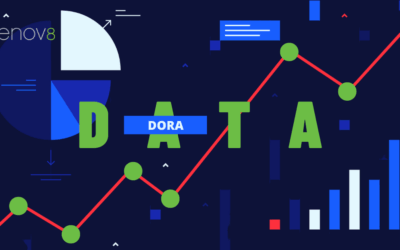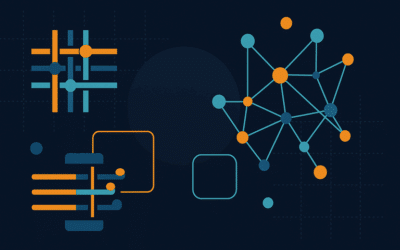
Methods to Improve Observability and Governance in the DevOps Life Cycles
28
October, 2021
by Sylvia Fronczak
To continue competing against fast-moving innovation, enterprises must improve their time to market while also improving product quality and efficiency. However, with speed comes risk. And if you’re not mitigating the risk, you may undo the value you’ve created with DevOps.
So what should you do? To start, companies typically begin by building out their DevOps knowledge and practices through transformation and automation. And although your DevOps transformation may have started to—and continues to—bring success and improvements in service maturity, there’s a missing piece.
The missing piece that we don’t always talk about involves governance—governance that ensures you’re improving speed and efficiency, while also providing controls and safeguards to comply with laws, regulations, and stakeholder expectations. This need doesn’t come from a place of control and bureaucracy. Instead, it comes from a place of wanting to know if you’re still headed in the right direction. And make sure you’re moving quickly while still mitigating risk and providing adequate compliance.
In this post (Methods to Improve Observability and Governance in the DevOps Life Cycles), we’ll review the DevOps landscape, talk about how observability and governance tie in, and then provide methods for you to incorporate both into your DevOps life cycle.
DevOps Recap
First, let’s focus on DevOps in the scope of software development and operations. Oftentimes people see DevOps as the CI/CD pipeline or application monitoring. That view paints an incomplete picture, as DevOps encompasses a variety of practices and cultures that help your team or organization deliver features and services to production quickly and with reliable quality.
As mentioned, DevOps includes many different practices, including the following. Please note that these should all be automated and as early in the life cycle as possible.
- Change management
- Feature prioritization
- Infrastructure as code
- Test automation
- Static code analysis
- Security testing
- Configuration management
At the heart of all these practices, the common themes of automation, repeatability, and observability shine through. With DevOps, we look to create an environment that makes shipping features easier by removing manual checkpoints and automating repetitive steps.
Combine that with a culture where teams look to standardize, automate, increase ownership, and decrease silos, and it may seem like we all have a long way to go. But with small steps, your enterprise can gain the DevOps skills and value that you need.
Now let’s explore what governance and observability provide in that model.
Governance and Observability
All the automation and streamlining that comes from DevOps provide a lot of benefits. But when building out your DevOps toolkit, you need to also consider governance and observability. But again, it’s not about adding extra steps or hurdles for your team. It requires automation and seamless integration with your team’s development life cycle.
Without proper governance and observability, you won’t be able to validate that controls account for risk and compliance. But without automation, you’ll miss out on the main benefits of DevOps. To begin, let’s cover the need for governance in your DevOps life cycle.
Governance
When we typically hear the term “governance model,” we think of checkpoints, bureaucracy, and approvals. When combined with DevOps automation principles, however, governance creates a set of guidelines for teams to follow, as well as the automation so that proper governance doesn’t slow the team down.
Instead of adding tasks to the product life cycle, these guidelines show teams how to automate tasks in a way that ensures quality and compliance. Additionally, the guidelines encourage teams to not reinvent the wheel but instead use the automation that’s already there properly, to make their jobs easier.
Think of governance as the North Star to which your DevOps automation efforts should point. And observability will then validate you’re headed in the right direction.
Observability
With observability, we want to take the automation from our governance model and provide visibility into not only how well the product is doing, but also how well the DevOps process is doing.
For example, if you’re considering improving the development pipeline for your development teams, consider what the developers need to know to ensure the product goes out quickly and with quality. But also consider what the maintainers of the pipeline need to know in order to improve. Furthermore, you can go a step further to automate tracking of proper training, test data management, and more.
Putting Both Together
If we look at observability and governance needs for teams, consider the following as a starting point.
- How are issues, bugs, and outages tracked and prioritized?
- How is change control managed and validated?
- What automated tests provide coverage, and how often do they catch problems?
- What security vulnerabilities were found or fixed with a code change?
- How quickly can teams deploy to a test environment or to production?
- Do certain types of changes result in increased production bugs or outages?
- Are quality issues caught early enough?
- Do teams follow proper compliance around documentation, separation of duties, and auditability rules?
- Can the code running in each environment tie back to specific versions or changelogs?
All of these require tracking but should not create blocks or additional hurdles for the team to surmount with every release. These are not manual checks or reports. They support and streamline work through the flow of the team.
Where Should You Start?
To have fully automated and observable governance throughout the DevOps life cycle can seem overwhelming.
To start, look at manual processes and governance, approvals, or bureaucracy. For example, what automation can provide more accurate and trusted results? How can you integrate the CI/CD pipeline with the release management and change control systems? And which will provide more value?
Next, to improve observability, assess the visibility you currently have in the DevOps life cycle. Does someone manually create reports or audits to review various steps? Do teams manually track what goes out in each deployment? Are people jumping from system to system to validate that new features are ready for production? What blind spots exist where visibility and auditability are lacking?
For issues with change control governance and observability, look for opportunities to streamline the process and automate how data between different systems ties together. Tie in auditability so that no one has to manually validate that changes to code or configuration are tracked properly.
And finally, incorporate standardization. Though teams need autonomy and the ability to deliver software the best way they know how, a bit of standardization will smooth out the process. If every team re-implements monitoring or CI/CD, they can’t build on each other’s learnings or automate everything efficiently. So standardize what makes sense and what gives teams common tools to solve repeated problems.
Summary
When building out your DevOps observability and governance model, find ways to automate and streamline as much as possible. Look at ways of making governance continuous throughout the life cycle of the application and not just steps along the way. And make sure you have the observability in place to know when things go wrong or when they can be improved. Finally, standardize common processes and tools that all teams need so they can improve efficiency and gain value from automation across all teams.
Learn more about how Enov8 can help with bringing visibility to your environments, data, and configuration management. Work with us to embed automation and best practices throughout the DevOps life cycle to start your governance journey. And gain peace of mind that DevOps practices not only improve the software process but also mitigate risk and compliance concerns.
Post Author
This post was written by Sylvia Fronczak. Sylvia is a software developer that has worked in various industries with various software methodologies. She’s currently focused on design practices that the whole team can own, understand, and evolve over time
Relevant Articles
DORA Compliance – Why Data Resilience is the New Digital Battlefield
How Enov8 Helps Financial Institutions Align with the EU's Digital Operational Resilience Act Executive Introduction As of January 2025, the EU's Digital Operational Resilience Act (DORA) has become legally binding for financial institutions operating across the...
Data Fabric vs Data Mesh: Understanding the Differences
When evaluating modern data architecture strategies, two terms often come up: data fabric and data mesh. Both promise to help enterprises manage complex data environments more effectively, but they approach the problem in fundamentally different ways. So what’s...
What Is Release Management in ITIL? Guide and Best Practices
Managing enterprise software production at scale is no easy task. This is especially true in today’s complex and distributed environment where teams are spread out across multiple geographical areas. To maintain control over so many moving parts, IT leaders need to...
Test Environment: What It Is and Why You Need It
Software development is a complex process that requires meticulous attention to detail to ensure that the final product is reliable and of high quality. One of the most critical aspects of this process is testing, and having a dedicated test environment is essential...
PreProd Environment Done Right: The Definitive Guide
Before you deploy your code to production, it has to undergo several steps. We often refer to these steps as preproduction. Although you might expect these additional steps to slow down your development process, they help speed up the time to production. When you set...
What is Data Tokenization? Important Concepts Explained
In today’s digital age, data security and privacy are crucial concerns for individuals and organizations alike. With the ever-increasing amount of sensitive information being collected and stored, it’s more important than ever to protect this data from...










